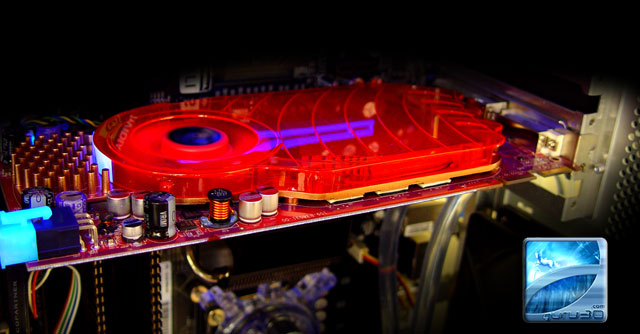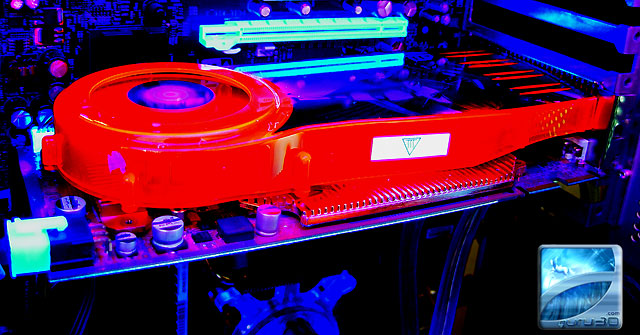Page 2 - Specs
All hail the new naming schema
Alright, before we dive into the actual technology I wanted to discuss what you probably already have noticed on the first page. There are no more Pro, XT, XTX, GT extensions in the product names are there? Ah yes my friend... and thank you AMD. Finally naming the way it's meant to be understood, this one makes sense if you think about it for a second. So let me explain first how you need to look at the new naming schema:
Let's take the new ATI Radeon HD 3870.
- The first number, 3, denotes the Generation.
- The second number, in this case x8xx, is Family
- The last two digits, xx70 is the Variant. 70 is equivalent to XT, 50 is the new name for Pro

Simple and easy, the higher the number the faster and newer the product shall be. Inevitably with the next generation variants of the 2400 and 2600 released, expect to see a 3x50 and 3x70, and likely with a few other variants as well.
Here's where we land at RV670
RV670 is the codename for the chip under the hood of the HD 3850 & 3870 graphics cards. Make no mistake, both cards make use of exactly the same graphics processor, making that 3850 a very interesting to purchase graphics card (150 USD) Yes, that price is almost creepy isn't ? Back to the dirty tech talk though; the new RV670 by all means is not just a die-shrink of R600. It does fix a lot of inefficiency issues that ATI faced with R600 (Radeon HD 2900). The processor is now manufactured at a much smaller 55nm process and entails a significant number of improvements. Let's walk through the more important ones.

For me personally the biggest improvement of the 38xx series GPU is two-fold. You'll get near same performance as a HD 2900 HD at half the price and secondly, half the power consumption (thus lower wattage). Do you guys remember that the 2900 cards had two power connectors (one 75W 6-pin & one 150W 8-pin) ? That's completely obsolete. Just a 6-pin connector will be sufficient as the fastest model announced today (HD 3870) uses merely half the Wattage of that 2900 XT at roughly 105 Watt (peak).
There are a number of reasons for the decrease in power consumption. Obviously the 55nm fabrication process is showing it's advantages there as the smaller a die size is the less voltage it requires.
Let me try to explain in a very laymen explanation:
Think of soccer [Ant - ehm... football for us Europeans please]. Flood a football field with water. And instead of kicking the ball we use the water flow to get the ball from point A to B. Now we cut that football field in half yet have the same amount of players play soccer, this would mean we'd use less water. And the soccer players would get their football quicker from point A to B as the distance is shorter. In the case of this silicon, the soccerfield is the RV670, water would be the current flowing through the silicon. The soccer players the transistors and the football the data transmitted.
Next to that smaller die-size AMD also incorporated ATI Powerplay (known from their mobile products) into the GPU which seems to do wonders in power consumption as it can regulate voltage levels, clock speeds on the fly. Pretty brilliant, we'll show you some results later on.
Radeon HD 3850
The lower-end Radeon HD 3850 will feature a silent single-slot cooler. Both cards have an optional 256MB or 512MB onboard GDDR3 memory configuration. The 3850 will be running at a 825 MHz memory frequency (1650 MHZ effective), and will have a core frequency of at least 660 MHz. I say at least as some board-partners will very likely release pre-overclocked models of these cards.
To cut cost the card is back to GDDR3 memory at a 256-bit memory bus. Memory and core frequency will differ per manufacturer here and there as there's still room for faster clocked products. Expect the 256MB version to sell for only 150 USD and the 512 MB version form 199 USD which is amazing value for the money considering you have a fully working RV670 GPU on that card. Have a peek. In the next pages we'll show you the board-partner cards in more detail.

Radeon HD 3870
The more "higher-end" Radeon HD 3870 is the slightly faster version of the 3850, it comes with a dual-slot cooler quite similar to the HD 2900 series yet this time offers a pretty silent solution. It will feature 256-bit GDDR4 opposed to GDDR3 while using the same RV670 core found on HD 3850. This GDDR4 memory is clocked at an astounding 1.1 GHz (2250 MHz effective), and the core frequency is set at a pretty dandy 775 MHz. Soon you'll likely spot slightly cheaper GDDR3 versions of the HD 3870 as well with the same core frequency as the GDDR4 card.

What's quite interesting is that AMD is doing more with less, and in this case I mean transistors. A demonic number of transistors are accounted for in the RV670 silicon, 666 Million, slightly less than the 80nm HD 2900 XT at 700 Million transistors. Performance between the two is close to NIL, in fact the 3870 will be slightly faster here and there. But we'll cover that in our benchmark run of course. Aesthetics wise, it's a pretty nice card to look at.
